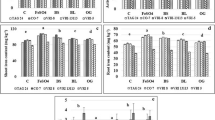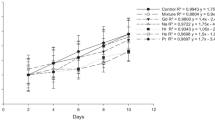Abstract
EighteenBradyrhizobium spp. strains, fourRhizobium spp. strains and oneAzorhizobium caulinodans strain were grown under Fe limitation and assayed for siderophore production. It was further assessed if Fe accumulation in two groundnut cultivars was influenced by inoculant strain or nitrate fertilisation. Growth ofBradyrhizobium spp. strains nodulating groundnut was slow with mean generation times from 11–24 h. All strains, except MAR 967, showed a reduced growth rate when deprived of Fe; none of the strains showed starvation at 1 μM Fe. In the CAS (chrome azurol S)-agar assay, all strains, which formed colonies, produced siderophores as visualised by orange halos around the colonies on blue plates.Bradyrhizobium strains produced much smaller halos than the referenceRhizobium meliloti strain. In the CAS-supernatant assay, all strains, except MAR 967, gave positive responses (measured as absorbance at 630 nm) when supernatants of Fe-depleted cultures were assayed with CAS-indicator complex in comparison with Fe-supplemented cultures. Responses of all fourRhizobium spp. strains were large, while responses of allBradyrhizobium strains, exceptB. japonicum MAR 1491 (USDA 110), were small and mostly insignificant. A small response, i.e. a low Fe-scavenging ability, implies either the production of small quantities of siderophores or the production of low affinity siderophores. Among theBradyrhizobium strains, MAR 1574 and MAR 1587 gave the largest responses taken over the two assays. Fe accumulation in groundnut cultivar Falcon was seven times larger than in cultivar Natal Common. No correlation was found between the quantity of nodule tissue and Fe accumulation, making it unlikely that bacteroids are involved in Fe acquisition by groundnuts. Nitrate-fertilised plants accumulated significantly more Fe, suggesting involvement of nitrate reductase in Fe assimilation in groundnut. The two most successful Fe-scavengingBradyrhizobium spp. strains were also the most effective in nodulating groundnut, the reverse also being true. Strain MAR 967, with the lowest Fe requirement, produced the largest nodule dry weight. These data indicate that improved Fe scavenging properties and/or reduced Fe requirement improve rhizospheric growth and with that nodulation effectiveness.
Similar content being viewed by others
References
Allen O N and Allen E K 1940 Response of the peanut plant to inoculation with rhizobia, with special reference to morphological development of the nodules. Bot. Gaz. 102, 121–142.
Ames-Gottfred N P, Christie B R and Jordan D C 1989 Use of chrome azurol S agar plate technique to differentiate strains and field isolates ofRhizobium leguminosarum biovartrifolii. Appl. Environ. Microbiol. 55, 707–710.
Bossier P, Hofte M and Verstraete W 1988 Ecological significance of siderophores in soil. Adv. Microb. Ecol. 10, 385–414.
Carson K C, Holliday S, Glenn A R and Dilworth M J 1992 Siderophore and organic acid production in root nodule bacteria. Arch. Microbiol. 157, 264–271.
Crowley D E, Wang Y C, Reid C P P and Szaniszlo P J 1991 Mechanisms of iron acquisition from siderophores by microorganisms and plants. Plant and Soil 130, 179–198.
Fuhrmann J and Wollum A GII 1989aIn vitro growth responses ofBradyrhizobium japonicum to soybean rhizosphere bacteria. Soil Biol. Biochem. 21, 131–135.
Fuhrmann J and Wollum A GII 1989b Nodulation competition amongBradyrhizobium japonicum strains as influenced by rhizosphere bacteria and iron availability. Biol. Fertil. Soils 7, 108–112.
Gill P R, Barton L L, Scoble M D and Neilands J B 1991 A high affinity iron transport system ofRhizobium meliloti may be required for efficient nitrogen fixation inplanta. Plant and Soil 130, 211–217.
Guerinot M L 1991 Iron uptake and metabolism in the rhizobia/legume symbioses. Plant and Soil 130, 199–209.
Guerinot M L, Meidl E J and Plessner O 1990 Citrate as a siderophore inBradyrhizobium japonicum. J. Bacteriol. 172, 3298–3303.
Jadhav R S and Desai A J 1992 Isolation and characterization of siderophore from cowpeaRhizobium (peanut isolate). Current Microbiol. 24, 137–141.
Jadhav R S and Desai A 1994 Role of siderophore in iron uptake in cowpeaRhizobium GN1 (peanut isolate): possible involvement of iron repressible outer membrane proteins. FEMS Microbiol. Lett. 115, 185–190.
Jurkevitch E, Hadar Y and Chen Y 1988 Involvement of bacterial siderophores in the remedy of lime-induced chlorosis in peanuts. Soil Sci. Soc. Am. J. 52, 1032–1037.
Ko M P, Huang P-Y, Huang J-S and Barker K R 1987 The occurrence of phytoferritin and its relationship to effectiveness of soybean nodules. Plant Physiol. 83, 299–305.
Lesueur D, Diem H G and Meyer J M 1993 Iron requirement and siderophore production inBradyrhizobium strains isolated fromAcacia mangium. J. Appl. Bacteriol. 74, 675–682.
Mengel K and Kirkby E A 1982 Principles of Plant Nutrition: Iron. Intern. Potash Institute, Bern, Switzerland. pp 473–489.
Modi M, Shah K S and Modi V V 1985 Isolation and characterisation of catechol-like siderophores from cowpeaRhizobium RA-1. Arch. Microbiol. 141, 156–158.
Nambiar P T C 1985 Response of groundnut (Arachis hypogaea L.) toRhizobium inoculation in the field: problems and prospects. MIRCEN J. 1, 293–309.
Nambiar P T C and Sivaramakrishnan S 1987 Detection and assay of siderophores in cowpea rhizobia (Bradyrhizobium) using radioactive Fe (59 Fe). Letters in Appl. Microbiol. 4, 37–40.
O'Hara G W, Dilworth M J, Boonkerd N and Parkpian P 1988a Iron-deficiency specifically limits nodule development in peanut inoculated withBradyrhizobium sp. New Phytol. 108, 51–57.
O'Hara G W, Hartzook A, Bell R W and Loneragan J F 1988b Response toBradyrhizobium strain of peanut cultivars grown under iron stress. J. Plant Nutr. 11, 6–11.
Parke D and Ornston L N 1984 Nutritional diversity ofRhizobiaceae revealed by auxanography. J. Gen. Microbiol. 130, 1743–1750.
Redinbaugh M G and Campbell W H 1983 Reduction of ferric citrate catalyzed by NADH:nitrate reductase. Biochem. Biophys. Res. Commun. 114, 1182–1188.
Römheld V 1987 Existence of two different strategies for the acquisition of iron in higher plants.In Iron Transport in Animals, Plants and Microorganisms. Eds. G Winkelmann, D van der Helm and J B Neilands. pp 353–374. VCH Chemie, Weinheim, Germany.
Römheld V and Marschner H 1983 Mechanism of iron uptake by peanut plants. I. Fe(III) reduction, chelate splitting, and release of phenolics. Plant Physiol. 71, 949–954.
Schlegel H G 1992 Incomplete oxidations.In General Microbiology. Ed. H GSchlegel. pp 327–350. Cambridge University Press, Cambridge, U.K.
Schwyn B and Neilands J B 1987 Universal chemical assay for the detection and determination of siderophores. Anal. Biochem. 160, 47–56.
Singh D and Sahu M P 1993 Effects of phosphate carriers, iron and indoleacetic acid on iron nutrition and productivity of peanut on a calcareous soil. J. Plant Nutr. 16, 1847–1855.
Tang C, Robson A D and Dilworth M J 1991 Inadequate iron supply and high bicarbonate impair symbiosis of peanuts (Arachis hypogaea L.) with differentBradyrhizobium strains. Plant and Soil 138, 159–168.
Terry R E, Hartzook A, Jolley V D and Brown J C 1988 Interactions of iron nutrition and symbiotic nitrogen fixation in peanuts. J. Plant Nutr. 11, 811–820.
Tiffin L O 1970 Translocation of iron citrate and phosphorus in xylem exudate of soybean. Plant Physiol. 45, 280–283.
VanRossum D, Muyotcha A, DeHoop B M, VanVerseveld H W, Stouthamer A H and Boogerd F C 1994 Soil acidity in relation to groundnut-Bradyrhizobium symbiotic performance. Plant and Soil 163, 165–175.
VanRossum D, Muyotcha A, VanVerseveld H W, Stouthamer A H and Boogerd F C 1993 Effects ofBradyrhizobium strain and host genotype, nodule dry weight and leaf area on groundnut (Arachis hypogaea L. ssp.fastigiata) yield. Plant and Soil 154, 279–288.
Zaharieva T and Römheld V 1991 Factors affecting cation-anion uptake balance and iron acquisition in peanut plants grown on calcareous soils. Plant and Soil 130, 81–86.
Author information
Authors and Affiliations
Rights and permissions
About this article
Cite this article
van Rossum, D., Muyotcha, A., van Verseveld, H.W. et al. Siderophore production byBradyrhizobium spp. strains nodulating groundnut. Plant Soil 163, 177–187 (1994). https://doi.org/10.1007/BF00007966
Received:
Accepted:
Issue Date:
DOI: https://doi.org/10.1007/BF00007966




